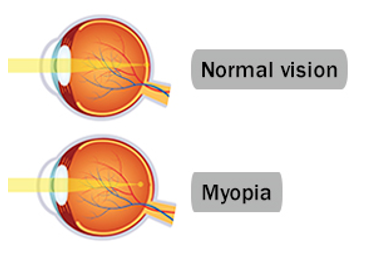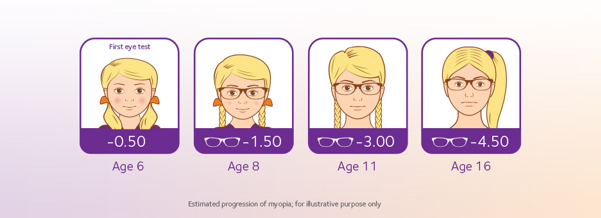Myopia is commonly known as being short-sighted. It means you can see things closer to you, but not further away. This is due to the length of the eyeball being too long. This causes images to focus in front of the retina, and therefore appear blurry.

Source: https://www.webmd.com/eye-health/nearsightedness-myopia#1
Who is affected?
In 2010 it was estimated that there were 2billion people with myopia. This is set to increase to a staggering 5billion in 20501.
Due to their continued growth, children and teenagers usually face a progression of myopia. Often this can mean their vision and therefore spectacle prescription can change every time they come for an eye exam – even when under 6 monthly review2 (see example below).

Source: https://coopervision.co.uk/contact-lenses/misight-1-day
Genetics increases the risk of a child being myopic. A child without a myopic parent has a 25% chance of being myopic. If one parent is myopic, then the risk of a child having myopia increases by 3x, and if both parents are myopic, this rises to 6x3.
Why is the prevalence of myopia increasing?
Recent studies have shown that new patterns of lifestyle are contribution to the increase in myopia worldwide. An increase in close work, especially electronic devices such as tablets and phones, poor lighting and the reduced amount of time that children spend outside have all been found to contribute to an increased risk for the development and progression of myopia3.
Why is it a problem?
Not only does myopia mean dependence on vision correction, but as myopia progresses, the risk of related ocular health issues also increases. This includes retinal detachment, glaucoma and myopic maculopathy. Each of these can cause irreversible vision loss.
So, what can we do about it?
- Changes in lifestyle – try to reduce the amount of time your child spends on electronic devices and increase their time outdoors. Studies have shown that spending more time outdoors may decrease the risk of myopia or myopia progression4.
- Ensure regular eye check-ups – children do not always appreciate there is something wrong with their eyes. All children under 16 in the UK are entitled to a yearly NHS eye exam. Here at VisionCare Optometry we are happy to see children regularly from the age of 3, and sooner if you have concerns (especially if there is a family history of eye related problems such as squint and/or lazy eye). You don’t have to wait for your child to be able to read letters, or even speak!
- Myopia Control contact lenses – we now fit Coopervision MiSight® 1 day lenses. Unlike standard contact lenses and spectacles, these lenses don’t just correct myopia, they may help to slow its progression too5. Where appropriate, we can fit children as young as 8 with these lenses.
- Myopia control spectacles – for those not suitable for contact lenses, we can now supply myopia control spectacles* which may also help to slow down the rate of myopia progression.
Please come in and speak to us about any concerns you may have about your child’s vision, and to discuss contact lens or spectacle solutions that may help.
More information can also be found on our Myopia Control page.
- Holden et al, Ophthalmology 2016
- Flitcroft DI. The complex interactions of retinal, optical and environmental factors in myopia aetiology. Prog Retin Eye Res. 2012;31(6):622-660
- https://coopervision.co.uk/eye-health-and-vision/childhood-short-sightedness/could-your-child-be-short-sighted
- Wolffsohn JS, Calossi A, Cho P, et al GlobalTrends in Myopia Management Attitudes and Strategies in Clinical Practice. Cont Lens Anterior Eye. 2016;39’106-16.
- Chamberlain P, et al. Clinical evaluation of a dual-focus myopia control 1 day soft contact lens – 3-year results BCLA 2017
*Not fully covered by NHS GOS3 voucher

